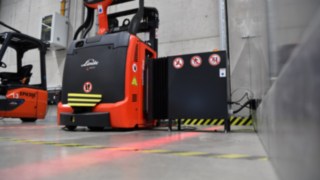... The Linde Material Handling way
Safety in Automation
Following our webinar, we received an influx of questions regarding the safety features in our automated solutions, so we thought we would aim to answer some of these questions and highlight why safety is one of the main benefits of our automated solution!
So what are the key safety features of the ‘Matic’ trucks when working alongside people...?
Whilst our range of Matic trucks are designed to work autonomously, it is likely that there will still be a presence of employees working in these operations. Therefore, we have designed our trucks to navigate so precisely to ensure the safety of individuals in the workspace. The trucks detect people and other vehicles in the environment. It doesn’t just stop at people and other vehicles - they are also designed to spot and detect other obstacles such as misplaced pallets and other debris.
Intelligent controls and PLD rated scanners (pedestrian level detection) on the vehicle control the truck braking system so they can promptly respond to any obstacles. The trucks can then automatically resume their task. This safety feature is enhanced for use in conjunction with people as the trucks are fitted with easily accessible emergency stop switches.
We received many questions which delved deeper into the intricacies of the Linde safety systems on our automated trucks. For example "Does the AGV need ‘line of sight’ to detect a person and what particular role does the 3D camera play?”
To the first part of the question the answer is yes, the AGV will have two safety zones. The first one is the Emergency Zone field, which is the area defined by the speed of travel and an adaptive safety field that looks ahead and around corners as it travels. If no one enters either the slow down or emergency stop fields, the vehicle will continue to travel. The second one is an adaptive safety field. This is set on the vehicle to change in relation to the speed and direction the vehicle is travelling in.
The second part of the question is in reference to the 3D camera fitted to our automated vehicles. This camera is primarily used for the safety of the goods when loading and unloading the pallet on the forks/within the racking system. The 3D camera is there to mainly detect two things: First, is the location empty? and second, where the fork pockets are to enable accurate positioning of the forks before pickup.
Finally we were asked “How do you manage manual intervention safely to repair rack damage, interface with conventional fork lift trucks, or if a unit loses charge in situ and has to be recovered?”
The first thing we would say is that it is imperative to keep a safe working space in all material handling operations. Should an engineer be present in the area that needs work, it is advised to secure the area to ensure a safe working environment.
With regards to the question surrounding the interface with conventional fork lift trucks… our automated trucks are designed to co-exist with other vehicles and people!
Addressing the final part of this question, the robot manager controls when a truck needs to be charged. The majority of AGV’s have automatic charging through a docking station needing no manual intervention. Couple this with a L-ion power source you have a totally maintenance free solution.
We hope that these answers have gone some way in informing you about our automated solutions and addressed some of the questions you may have.
If you would like to learn more, please follow the link below to watch our webinar. Alternatively, you can chat with us now using the Chat function at the bottom of the screen.
